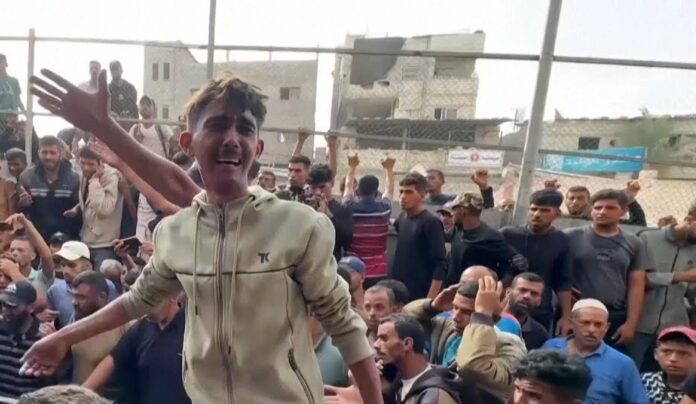Witnesses say Israeli forces opened fire on desperate Gazans queuing for aid; over 200 injured in attack.
Fifty-one Palestinians were killed and more than 200 wounded after Israeli forces opened fire near a flour distribution site in Khan Younis, southern Gaza, on Tuesday, according to eyewitnesses and local rescue teams. The deadliest in a growing series of violent incidents near food aid convoys, the attack has further exposed the perilous conditions faced by starving Gazans.
The incident unfolded east of Khan Younis, where thousands of people had gathered near a World Food Programme (WFP) distribution site and community kitchen. Witnesses described a sudden and brutal escalation—two missiles fired from Israeli drones, followed by tank shells raining down from just 500 metres away.
According to Gaza’s Hamas-run civil defence agency, the IDF opened fire on civilians with drones and artillery as they queued in hopes of receiving flour. Nasser Hospital, the only major facility still functioning in the area, was overwhelmed by the surge of casualties. Images and videos from the scene showed patients lying on the floor, bloodied and untreated, as medical staff scrambled to respond.
“This is again the result of another food distribution initiative,” said Dr Thanos Gargavanis, trauma surgeon and WHO emergency officer. “The trauma injuries are almost all gunshot wounds.”
The IDF issued a guarded response, saying a crowd had gathered near a “stuck” aid truck in proximity to Israeli troops. They acknowledged being “aware of reports” of injuries caused by IDF fire and said the incident was under review.
Video verified by BBC journalists showed the aftermath of the strike at a location consistent with the reported aid distribution site. The UN and international NGOs said this is part of a disturbing pattern: a collapse in security surrounding humanitarian aid delivery in Gaza, often resulting in lethal force used against civilians.
For the past several weeks, aid deliveries have become magnets for chaos and death. A new system run by the Gaza Humanitarian Foundation (GHF)—backed by Israel and the US—has drawn massive crowds of starving civilians to just a few aid points. The result: daily scenes of looting, stampedes, and now routine shootings.
The Israeli army has insisted that troops fire only warning shots at individuals they deem threats. But the sheer number of casualties, coupled with mounting reports from medical teams and human rights groups, has cast doubt on the proportionality—or legality—of those responses.
UN human rights chief Volker Türk said Israel is “weaponising food” and called for an independent investigation. UNRWA chief Philippe Lazzarini lamented the world’s shifting focus: “In Gaza, tragedies go on unabated while attention shifts elsewhere.”
The GHF has attempted to distance itself from the bloodshed, claiming the shootings occur outside their officially designated aid zones. But critics argue the new distribution system—created in part to sideline UN agencies and block alleged Hamas theft—has itself created “death traps.”
Israel’s blockade, compounded by the collapse of local law enforcement and the presence of armed gangs, has rendered Gaza lawless. According to WHO and humanitarian observers, nearly every day now brings new casualties tied to food deliveries rather than direct military strikes.
It has been 20 months since Israel launched its military campaign in response to Hamas’s October 2023 cross-border attacks that killed 1,200 Israelis and resulted in the abduction of 251 people. Since then, more than 55,000 Palestinians have been killed, according to the Gaza health ministry.
With no new plan to address the humanitarian catastrophe and prevent further killings, Gaza remains suspended in a deadly limbo. Desperate for food, civilians continue to risk their lives for flour. Many do not return.
